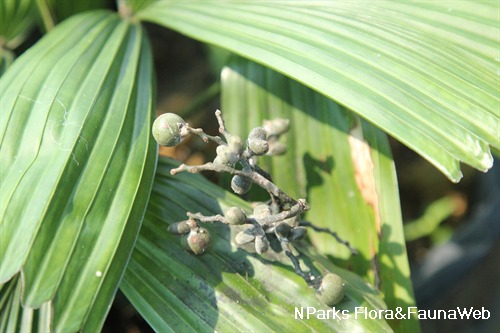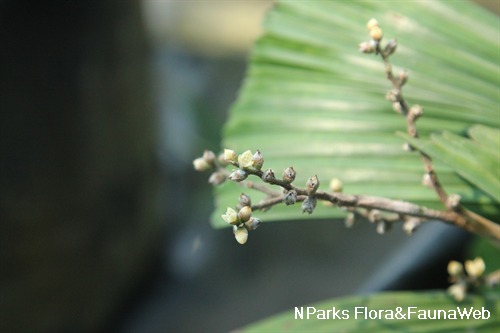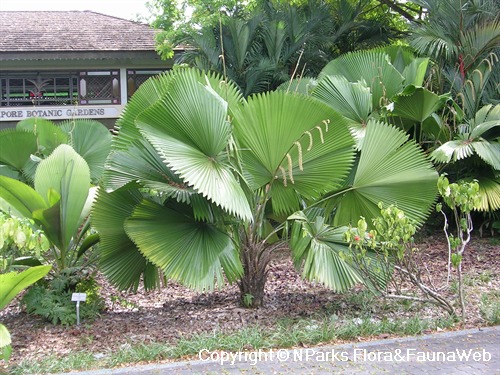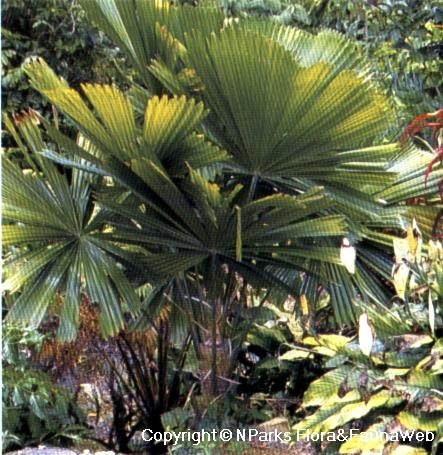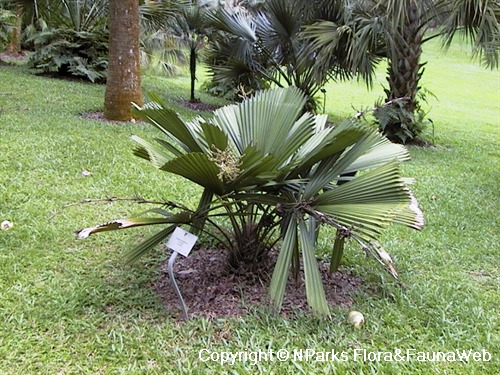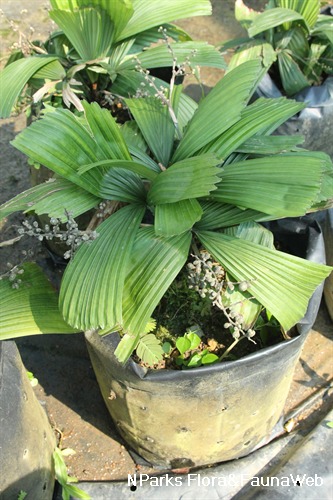
Back
Licuala triphylla Griff.
| Family Name: | Arecaceae (Palmae) |
| Synonyms: | Licuala filiformis Hodel, Licuala pygmaea Merr., Licuala stenophylla Hodel, Licuala ternata Griff., Licuala triphylla Ridl. var. integrifolia |
Name
Classifications and Characteristics
| Plant Division | Angiosperms (Flowering Seed Plants) (Monocotyledon) |
|---|---|
| Plant Growth Form | Palm (Solitary Habit) |
| Lifespan (in Singapore) | Perennial |
| Mode of Nutrition | Autotrophic |
| Plant Shape | Irregular |
Biogeography
| Native Distribution | Southern Thailand to Peninsular Malaysia, Singapore, and Borneo |
|---|---|
| Native Habitat | Terrestrial (Primary Rainforest) |
| Preferred Climate Zone | Tropical |
| Local Conservation Status | Native to Singapore (Extinct (EX)) |
Description and Ethnobotany
| Growth Form | It is an understorey solitary palm up to 1 m tall. Its stems are underground, curved, and with very short internodes. Its small to medium-sized fan-shaped leaves have long petioles and laminas that are palmate, 6–10 leaves on the crown, originating from the base of the plant, and are erect or arching. |
|---|---|
| Foliage | Its alternate, stalked, small to medium-sized leaves are erect or arching, fan-shaped, palmate, and up to 1.5 m long. The petioles are about 0.5–1 m long, with irregularly sized, small, thin, reflexed spines, irregularly spaced along the lower third of the stalk. The laminas are small, fan-shaped to round, 22–50 cm wide, palmate with 3–11 leaflets, and dull green on both surfaces. The central leaflet is larger than the rest of the leaves and may be stalked. |
| Stems | Its stems are underground, curved, and with very short internodes. |
| Crown Shaft | Absent. |
| Flowers | Its small flowers are 4 mm long and borne on a branched, spreading inflorescence, that is erect or arching, shorter than the leaves, and 15–40 cm long. |
| Fruit | Its green fruits are orange when ripe, round, and about 1cm in diameter. |
| Habitat | It grows in wet lowland or dipterocarp forests. |
| Associated Fauna | Its flowers are insect-pollinated. Its fruits and seeds are probably eaten and dispersed birds. |
| Cultivation | It can be propagated by seed. |
| Etymology | Makassar (Moluccan) leko wala, referring to Licuala spinosa; Latin triphylla, three-leaved, referring to the commonly seen 3-leaflet leaves of this species, although may have up to 11 leaflets |
| Ethnobotanical Uses | Others: It has horticultural potential as an ornamental palm. |
Landscaping Features
| Landscaping | It may be suitable for parks. This plant is suitable for planting in moist, partially-shaded or shaded areas, for its attractive fan-shaped foliage. |
|---|---|
| Desirable Plant Features | Ornamental Foliage, Ornamental Fruits |
| Landscape Uses | General, Parks & Gardens, Small Gardens, Shade Providing Tree / Palm, Interiorscape/ Indoor Plant |
Fauna, Pollination and Dispersal
| Fauna Pollination Dispersal Associated Fauna | Bird-Attracting (Fruits) |
|---|---|
| Pollination Method(s) | Biotic (Fauna) |
| Seed or Spore Dispersal | Biotic (Fauna) |
Plant Care and Propagation
| Light Preference | Semi-Shade, Full Shade |
|---|---|
| Water Preference | Moderate Water |
| Plant Growth Rate | Moderate |
| Rootzone Tolerance | Moist Soils, Well-Drained Soils |
| Propagation Method | Seed |
Non - Foliar and Storage
| Trunk Type (Palm) | Clustering Habit, Aboveground |
|---|
Floral (Angiosperm)
| Flower Grouping | Cluster / Inflorescence |
|---|
Fruit, Seed and Spore
| Mature Fruit Colour(s) | Orange |
|---|---|
| Fruit Classification | Simple Fruit |
| Fruit Type | Fleshy Fruit |
Image Repository
Others
| Master ID | 30071 |
|---|---|
| Species ID | 4380 |
| Flora Disclaimer | The information in this website has been compiled from reliable sources, such as reference works on medicinal plants. It is not a substitute for medical advice or treatment and NParks does not purport to provide any medical advice. Readers should always consult his/her physician before using or consuming a plant for medicinal purposes. |

